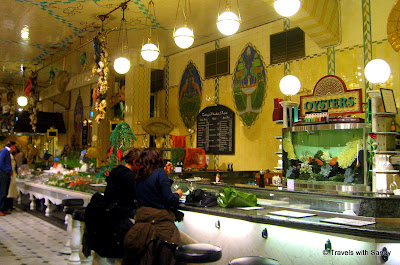Whenever I am shopping while abroad, I inevitably find myself in a food hall. At the most basic level, a food hall is any indoor area that offers a variety of food for sampling and purchasing. They are often found in department stores, but can also operate independently. A food hall is more than an indoor market or run of the mill mall food court, however. A food hall is above all an exhibition of local and international artisinal food.

Harrod’s famous food hall
The most famous food hall in the world is arguably Harrod’s in London. While for many destinations I end up in a food hall by coincidence, Harrod’s Food Hall was a must-see for me even before my arrival in London. Harrod’s was founded in 1834 as a wholesale grocery with a specialty in tea.

Harrod’s has some of the fanciest groceries I have ever seen.

There are lots of stands to try out at Harrod’s Food Hall.
After arriving at Harrod’s, I bypassed all other departments and made a beeline for the food hall. There’s better shopping in the United States. I was here for the food hall. I was not disappointed. In room after themed room, attractive gourmet food was presented to me, the shopper, for my perusal. If you want seafood, there is an entire room dedicated to these delicious creatures under the sea.

You can eat fresh oysters in the seafood room at Harrod’s food hall.
Need gifts for loved ones? Harrod’s has quite a selection of packaged ready to gift gourmet food items. Perhaps some proper English tea would delight your grandmother, or lemon cookies for your best friend, or Turkish Delight for your unsuspecting brother!

Indulge your sweet tooth at Harrod’s.
Before heading out, be sure to view the over the top escalators at Harrod’s. The escalators have an ancient Egyptian theme to honor the heritage of Mohamed al Fayed, the current owner of the department store. The escalator bay is also where you can find Princess Diana’s and Dodi al Fayed’s memorial.

The Egyptian decor is historically listed to protect against their removal and alteration.

Yep, that’s the actual face of Mohamed al Fayed on the Sphinx.
Despite Harrod’s fame, to many English residents the designation of best department store for gourmet food would belong to Fortnum & Mason, which has held royal warrants for 150 years. Harrod’s also holds some royal warrants, but Fortnum & Mason is more closely associated with British royalty and the peerage.

The circular stairway at Fortnum & Mason decorated for Christmas.
Although we had heard of Fortnum & Mason, it was by chance that we stumbled upon this establishment while shopping near Piccadilly Circus. I thought we had entered my version of department store heaven. Exquisitely decorated for Christmas, Fortnum and Mason offered all kinds of British foodstuffs, from minced pies to jars of ribbon candy to traditional china. Fortnum & Mason is most well known for its teas and luxury picnic hampers.

A selection of Fortnum and Mason’s gourmet products with its signature turquoise label on display.
Fortnum & Mason’s food hall is not to be missed for foodies the world over!

Inside Fortnum and Mason during the Christmas season.
These two luxurious food halls reminded me of my visit to the highly regarded Alois Dallmayr in Munich, Germany. The Dallmayr is a famous luxury delicatessen and food hall that has served European royalty since the 17th century. You can read about our day in Munich and see some more photos of Dallmayr here.

Alois Dallmayr plaque proclaiming its status as a royal purveyor.

Window display at Alois Dallmayr.

Inside Alois Dallmayr delicatessen.
Inspired by these elaborate European food halls, the Japanese created their own twist on the concept with depachikas, department store basement food halls. Similar to the Harrod’s concept, depachikas seek to create a high end retail experience, but for food. Only the best brands are offered, from sushi to desserts to mochi to tea and other delicacies. However, depachikas have a larger selection of freshly prepared takeaway meals for shoppers. Many professional stop by and pick up bento boxes for lunch and dinner on a daily basis. Another major difference is that Japanese department stores often directly rent out the spaces on the store floor to bakeries and food businesses. As a result, the salespeople of these kiosks do not necessarily work for the department store. These businesses of course have to pass a rigorous test of quality and name. A third distinction is that Japanese food halls tend to emphasize trendy food over more traditional flavors. You can read all about the depachika craze in this Food and Wine magazine article.
The Dessert comes First blog has an excellent post on food in Japan, including an entire section on depachikas with fantastic pictures. Here is the link to that specific post. I have included two of her photos below for reference.

Photo of depachika by Desserts comes First

Photo of depachika store display by Desserts comes First
I have visited the depachika in person at Isetan in Tokyo and Kaohsiung. You can read my entire post about the Isetan department store in Kaohsiung here. These basement food halls are one of my favorite places to just relax and eat. I wish the US had places like these – I would be there every night!

One of the stores within a store in the basement food hall at Isetan in Kaohsiung.






















































Recent Comments